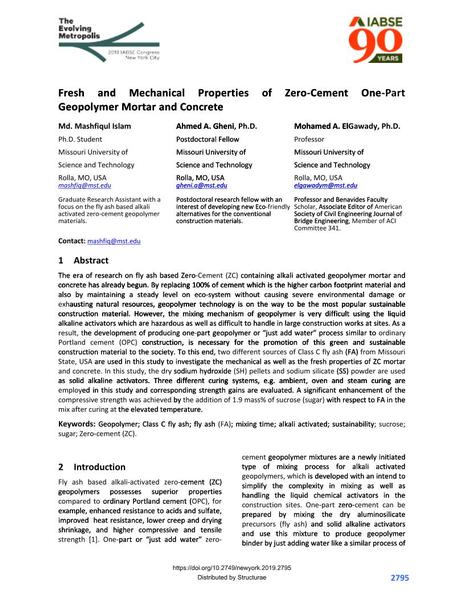Fresh and Mechanical Properties of Zero-Cement One-Part Geopolymer Mortar and Concrete

|
|
|||||||||||
Détails bibliographiques
| Auteur(s): |
Md. Mashfiqul Islam
(Missouri University of Science and Technology)
Ahmed A. Gheni (Missouri University of Science and Technology) Mohamed A. ElGawady |
||||
|---|---|---|---|---|---|
| Médium: | papier de conférence | ||||
| Langue(s): | anglais | ||||
| Conférence: | IABSE Congress: The Evolving Metropolis, New York, NY, USA, 4-6 September 2019 | ||||
| Publié dans: | The Evolving Metropolis | ||||
|
|||||
| Page(s): | 2795-2799 | ||||
| Nombre total de pages (du PDF): | 5 | ||||
| DOI: | 10.2749/newyork.2019.2795 | ||||
| Abstrait: |
The era of research on fly ash based Zero-Cement (ZC) containing alkali activated geopolymer mortar and concrete has already begun. By replacing 100% of cement which is the higher carbon footprint material and also by maintaining a steady level on eco-system without causing severe environmental damage or exhausting natural resources, geopolymer technology is on the way to be the most popular sustainable construction material. However, the mixing mechanism of geopolymer is very difficult using the liquid alkaline activators which are hazardous as well as difficult to handle in large construction works at sites. As a result, the development of producing one-part geopolymer or “just add water” process similar to ordinary Portland cement (OPC) construction, is necessary for the promotion of this green and sustainable construction material to the society. To this end, two different sources of Class C fly ash (FA) from Missouri State, USA are used in this study to investigate the mechanical as well as the fresh properties of ZC mortar and concrete. In this study, the dry sodium hydroxide (SH) pellets and sodium silicate (SS) powder are used as solid alkaline activators. Three different curing systems, e.g. ambient, oven and steam curing are employed in this study and corresponding strength gains are evaluated. A significant enhancement of the compressive strength was achieved by the addition of 1.9 mass% of sucrose (sugar) with respect to FA in the mix after curing at the elevated temperature. |
||||
